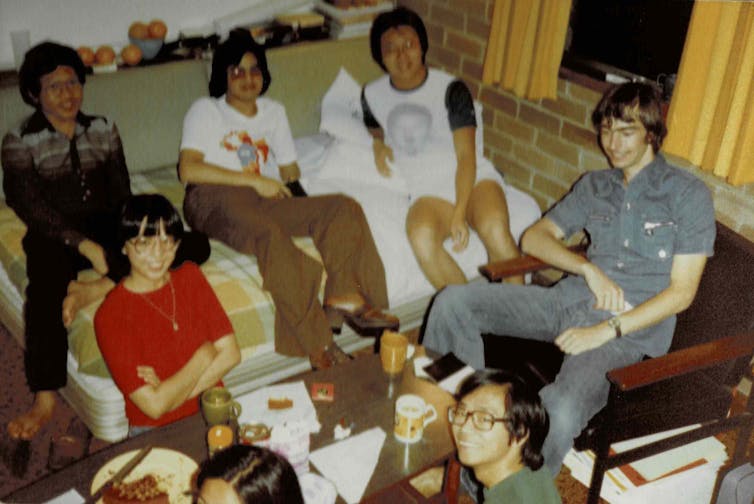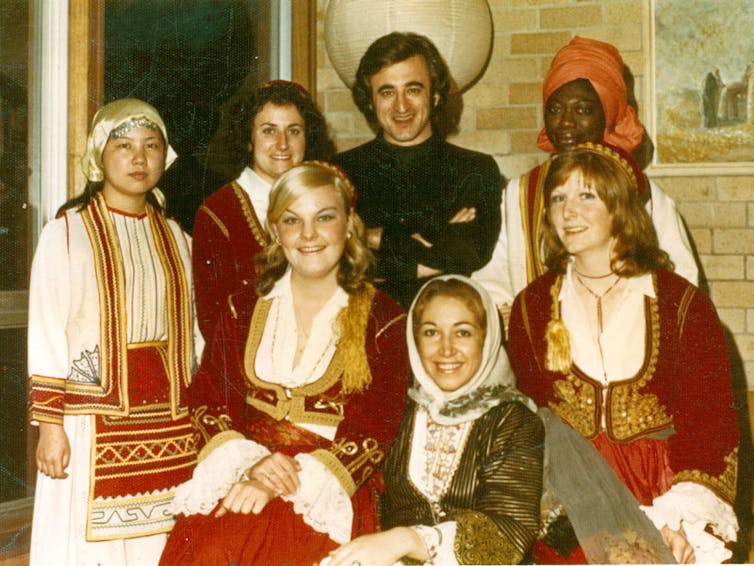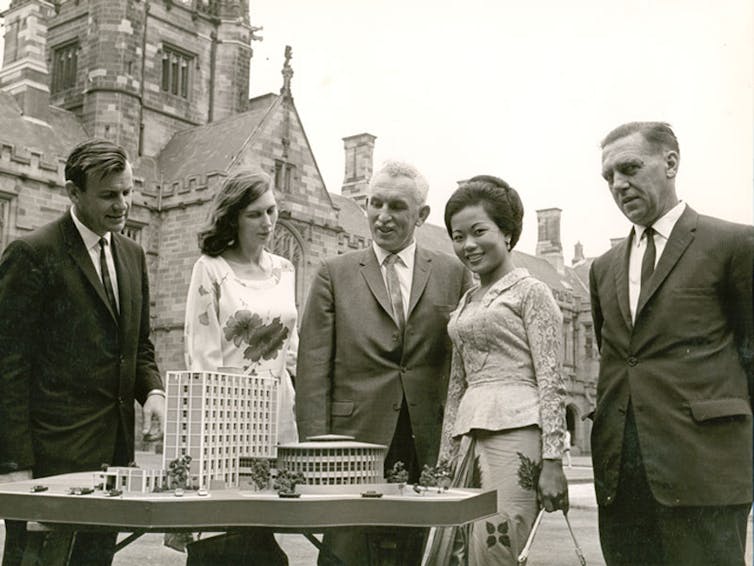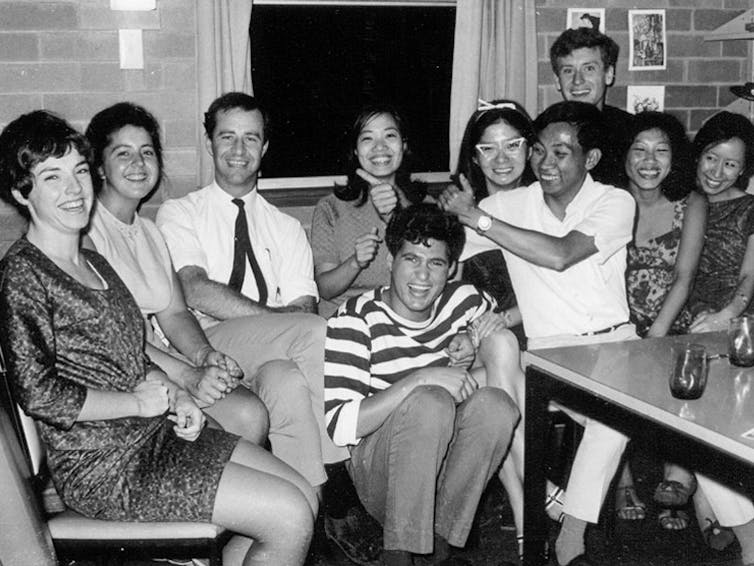the legacy of Sydney Uni's International House
- Written by Gregory Houseman, Emeritus Professor of Geophysics, University of Leeds
The end of an era is something of a cliché, but it’s the only way to describe the closure of Sydney University’s International House at the end of this year.
Prominently located on the corner of City Road and Cleveland Street, in Darlington, Sydney, it’s been home to many thousands of university students, both international and local, since 1967.
Read more: How unis can use student housing to solve international student quarantine issues
One of those local students was me. International House was my home for three years during the 1970s.
 The author (right) relaxing with friends in a resident’s room in 1975.
Gregory Houseman, Author provided
The author (right) relaxing with friends in a resident’s room in 1975.
Gregory Houseman, Author provided
My career as an academic led me to jobs in the US, Australia and eventually Leeds in the UK, but I still have fond memories and many friends made at Sydney IH.
A home away from home
The accommodation model of residential halls like International House provides the opportunity to socialise daily with a broad spectrum of people from different countries studying different courses.
The friendships made by those who have lived there are of enormous value to both the individual and society. What you learn from interacting with the kind of diverse population living there can equip you for living in a globalised world, better than anything you learn in class.
Read more: Why countries should leverage universities as a new force in global diplomacy
International House at Sydney University has its origins in a different era, when the White Australia policy was only recently discarded.
The federal government was only then getting around to constitutional amendments that protected the rights of the original Australians. International students were relatively few.
Some high-profile initiatives such as the Colombo Plan, an intergovernmental program designed to strengthen relationships within Asia and the Pacific, were in place and Australian universities had begun to attract privately funded foreign students.
Read more: Colombo Plan: An initiative that brought Australia and Asia closer
The universities saw the many benefits that could accrue from attracting foreign students, in particular the opportunity for students from other countries to interact with Australian students and to learn about each other’s cultures and attitudes.
 Times gone by: meet the ‘Greek’ dancers on one of the International Night celebrations at International House.
University of Sydney
Times gone by: meet the ‘Greek’ dancers on one of the International Night celebrations at International House.
University of Sydney
International House was an initiative to support that goal. It allowed foreign and Australian students to share the university experience at a deeper level than is possible when you only meet other students in formal lectures and tutorials.
The alumni of International House are testament to the many life-long friendships formed in this environment.
It started in New York
The idea of an International House came originally from Columbia University in New York in the 1920s. It was conceived by Harry Edmonds, a far-sighted man who resolved to overcome the barriers and isolation faced by foreign students in New York.
As Edmonds told the New York Times in 1979:
One frosty morning [in 1909] I was going up the steps of the Columbia library when I met a Chinese student coming down. I said, ‘Good morning.’ As I passed on, I noticed he stopped. I went back.
He said, ‘Thank you for speaking to me. I’ve been in New York three weeks and you are the first person who has spoken to me.’
With my wife’s insistence, I agreed I had to do something.
The support of prominent philanthropists like John D. Rockefeller junior helped Edmonds transform his idea of an International House into a reality.
The first International House in New York (meet the Australian at 3'33").The International House model has influenced the lives of many thousands of students, first at Columbia University but later in many cities around the world where the concept was adopted and thrived.
At Sydney University in the 1960s, the then deputy principal, Wilson Harold Maze, championed the concept but it was only realised with major sponsorship from Rotary International.
 Harold Maze (centre) and guests with an early model of International House in 1965.
University of Sydney
Harold Maze (centre) and guests with an early model of International House in 1965.
University of Sydney
Award-winning architect Walter Bunning designed the distinctive buildings, and the house officially opened its doors to students in 1967 under director Graeme de Graaf.
Where the world comes together
International House is more than just a student dormitory. Going to live there opened my eyes to a world view that sees people rather than nations, and cuts away much of the baggage associated with nationalism.
 Some of the early residents at International House in 1967.
University of Sydney
Some of the early residents at International House in 1967.
University of Sydney
Meals were taken together in a common dining hall where any resident could talk daily with others from around the world who were taking courses in anything that the university offered.
This daily give-and-take provided for me the essence of the university experience. One of the things you learn in a place like International House is that people basically have the same range of needs, wants, capabilities, problems and potential, wherever they come from.
At a time when populist politics too easily leads people to label others as different, or threatening, or somehow less good or less deserving, such institutions are more important than they have ever been.
Without this kind of environment, a foreign student can feel completely isolated, or fall too easily into the habit of mixing socially only with students who have come from the same country. They then never really experience what the host country has to offer.
Read more: 'I love Australia': 3 things international students want Australians to know
If you go to university with the objective of just learning the dry technical details encapsulated in the course you enrolled in, you miss a huge opportunity.
So what happens next?
Why then is International House closing on December 31 2020?
Those award-winning buildings now have some serious maintenance issues and are too small for what is required to keep residence fees at a competitive level. A redevelopment of the site is planned.
A candlelight and closure ceremony held at International House in November.We expect to see in coming years a new, larger complex on the same site. It should further develop the essential role of International House, providing a home and learning environment to many future generations of students who will end up working in Australia and around the world.
Authors: Gregory Houseman, Emeritus Professor of Geophysics, University of Leeds





